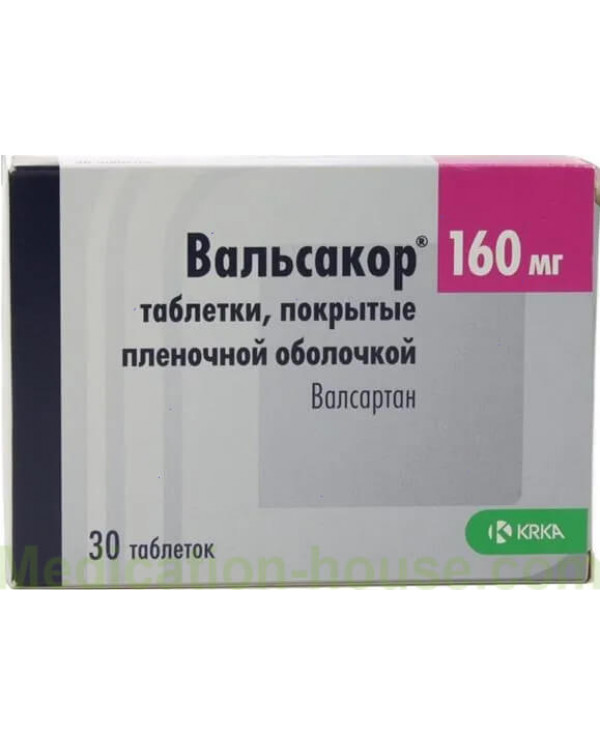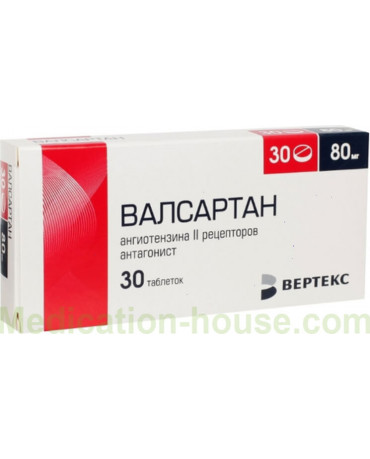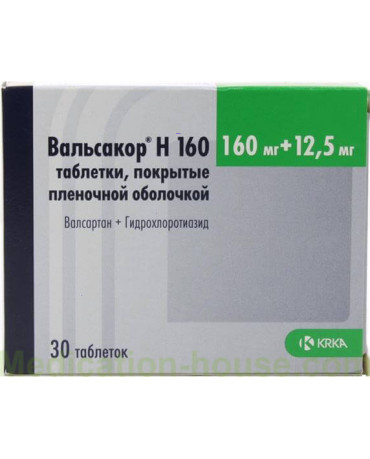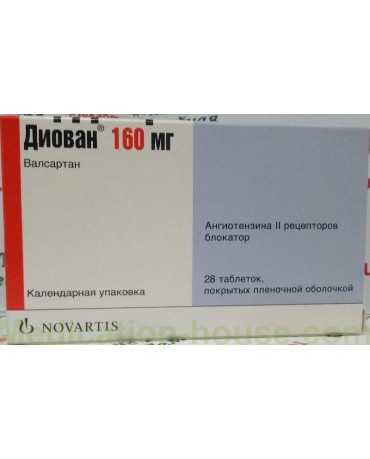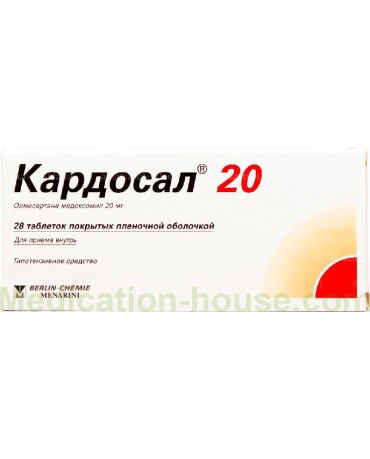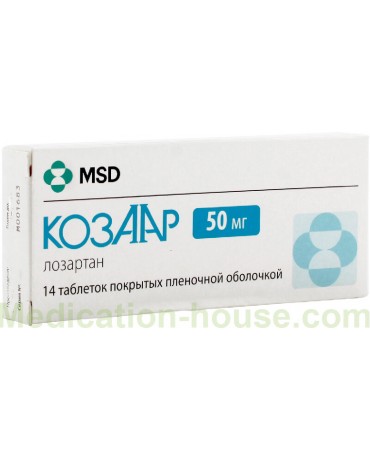Instruction for Valsacor
You can buy Valsacor here
Release form and composition
Valsacor is produced in the form of film-coated tablets, in blisters of 7 pcs. (40 mg, 80 mg and 160 mg each) and 14 pcs. (80 mg, 160 mg and 320 mg each).
The composition of 1 tablet contains the active substance - valsartan in the amount of:
40 mg - brownish-yellow tablets, slightly biconvex, round, with a line on one side;
80 mg - pink tablets, biconvex, round, with a line on one side;
160 mg - brownish-yellow tablets, biconvex, oval, with a line on one side;
320 mg - light brown tablets, biconvex, oval, with a line on one side.
Auxiliary components that make up the preparation: magnesium stearate, lactose monohydrate, microcrystalline cellulose, croscarmellose sodium, povidone, colloidal anhydrous silicon dioxide.
Composition of the tablet shell:
40 mg - macrogol 4000, E171 (titanium dioxide), hypromellose, E172 (iron oxide yellow dye);
80 mg - macrogol 4000, E171 (titanium dioxide), hypromellose, E172 (iron oxide red dye);
160 mg and 320 mg - macrogol 4000, E171 (titanium dioxide), hypromellose, E172 (iron oxide red dye), E172 (iron oxide yellow dye).
Indications for use
Chronic heart failure (NYHA classification - II-IV functional class) as part of complex therapy (simultaneously with standard therapy) and in patients not receiving ACE inhibitors;
Arterial hypertension;
Reduction of cardiovascular mortality in stable patients who developed left ventricular failure / dysfunction due to myocardial infarction.
Contraindications
Contraindications to the use of Valsacor are:
Lactose intolerance, glucose / galactose malabsorption syndrome or galactosemia;
Age up to 18 years (the safety and effectiveness of its use in children has not been proven);
Hypersensitivity to the active substance (valsartan) or to other components of the drug.
There are no data on the use of the drug during pregnancy. When pregnancy is established, Valsacor should be stopped immediately. For the fetus, the risk increases in the II and III trimesters.
There are no data on the excretion of valsartan in breast milk. Therefore, given the importance of therapy for the mother, it is necessary to decide whether to interrupt breastfeeding or stop taking the drug.
Valsacor should be taken with caution in the following conditions / diseases:
Liver failure with obstruction of the biliary tract;
Arterial hypotension;
Stenosis of an artery of a solitary kidney or bilateral stenosis of the renal arteries;
Renal failure (creatinine clearance <10 ml per minute), incl. patients on hemodialysis;
Sodium-restricted diet;
Hyponatremia;
Conditions accompanied by a decrease in the volume of circulating blood, including diarrhea, vomiting.
Method of administration and dosage
Valsacor is taken orally, regardless of the meal. Frequency rate of application - 1-2 times a day.
The recommended dose for hypertension (regardless of gender, age or race of the patient) is 80 mg once a day. The antihypertensive effect develops within 2 weeks, reaching its maximum after 4 weeks. The maximum daily dose is 320 mg. Patients with impaired renal and liver function of non-biliary origin and without cholestasis do not need to change the dose of the drug. Combined use with other antihypertensive drugs is possible.
In the treatment of chronic heart failure, the recommended initial dose is 40 mg, the frequency of administration is 2 times a day. The dose can be gradually increased to 80 mg, with good tolerance - up to 160 mg (maximum) 2 times a day. In patients simultaneously receiving diuretics, as well as in patients with heart failure, it is necessary to constantly monitor renal function and blood pressure. With the development of clinical signs of arterial hypotension, the dosage must be reduced.
When using Valsacor after an acute myocardial infarction in clinically stable patients, therapy should be started within 12 hours after the development of the disease. The initial dose is 20 mg 2 times a day (1/2 tablet 40 mg scored). Gradually, a single dose is increased to 40 mg, to 80 mg - after 14 days from the start of treatment, and brought to 160 mg after 3 months, without changing the frequency of administration. Achievement of the target dosage depends on the tolerability of the drug during the dose titration period.
In case of renal failure, or symptomatic or arterial hypotension, the dose of the drug should be reduced.
Assessment of the condition of patients after myocardial infarction should include monitoring of renal function.
Patients with impaired liver function of non-biliary genesis without cholestasis do not require dose adjustment.
Side effects
When using Valsacor, the development of side effects is possible, which manifests itself with different frequencies:
Respiratory system, chest and mediastinal organs: often - rhinitis, cough, pharyngitis, upper respiratory tract infections, sinusitis;
Central and peripheral nervous system: often - headache, vertigo, dizziness, incl. postural; infrequently - insomnia; sometimes - fainting (during therapy after myocardial infarction);
Skin and subcutaneous tissue: rarely - skin rash;
Genitourinary system: infrequently - decreased libido; very rarely - impaired renal function;
Cardiovascular system: often - orthostatic hypotension, marked decrease in blood pressure; sometimes - heart failure (during therapy after myocardial infarction);
Muscles, skeleton and connective tissue: often - myalgia, back pain, arthralgia;
Gastrointestinal tract: often - diarrhea, nausea, abdominal pain;
Laboratory parameters: often - hyperkalemia; rarely - a decrease in the concentration of hematocrit and hemoglobin, thrombocytopenia, neutropenia, hyperbilirubinemia, hypercreatininemia, an increase in serum urea nitrogen and hepatic transaminase activity;
Allergic manifestations: very rarely - itching, skin rash, angioedema, hypersensitivity reactions, including vasculitis and serum sickness;
Others: often - a state of general weakness; infrequently - asthenia, edema, increased fatigue.
Clinical data are insufficient, but despite this, the main expected manifestation of Valsacor overdose is a pronounced decrease in blood pressure, which can cause shock and / or collapse.
To alleviate the condition, it is recommended to induce vomiting, and then rinse the stomach. Hemodialysis is ineffective. When arterial hypotension occurs, intravenous administration of 0.9% sodium chloride solution is indicated.
Special instructions
The use of Valsacor in patients with heart failure is usually accompanied by a decrease in blood pressure, however, if the recommendations for the selection of doses are followed, arterial hypotension is rarely the reason for discontinuation of therapy. Patients with heart failure should be treated with caution. In some patients, due to suppression of the activity of the renin-angiotensin-aldosterone system, renal function may change. In severe heart failure, progressive azotemia and / or oliguria may develop up to acute renal failure and / or death (rarely). In patients with heart failure, it is necessary to constantly monitor renal function while using a combination of 3 classes of drugs - beta-blockers, ACE inhibitors and angiotensin II AT1 receptor antagonists.
It is possible to use Valsacor simultaneously with other drugs prescribed after a myocardial infarction: acetylsalicylic acid, thrombolytics, statins and beta-blockers.
In patients with a pronounced deficiency in the body of sodium and / or a reduced volume of circulating blood (for example, due to the intake of large doses of diuretics), severe arterial hypotension may sometimes occur at the beginning of treatment. Before starting therapy, it is recommended to restore the content of electrolytes and fluid in the body, in particular, by reducing the dose of diuretics.
If arterial hypotension occurs with clinical manifestations, the patient should be laid on his back. If necessary, a 0.9% sodium chloride solution is injected intravenously. Taking Valsacor can be continued only after the blood pressure indicators have stabilized.
In patients with unilateral or bilateral renal artery stenosis, serum urea nitrogen and serum creatinine should be monitored continuously.
In patients with impaired renal and liver function, dose changes are not required.
Due to the lack of sufficient data on the use of Valsacor in severe renal failure (creatinine clearance <10 ml per minute or 0.167 ml per second), the drug should be used with caution.
In patients with obstructive diseases of the biliary tract, a decrease in the clearance of Valsacor is observed, and therefore the drug should be prescribed with caution.
During therapy, patients are advised to be careful when driving vehicles and other mechanisms that require increased attention from them.
Drug interactions
The simultaneous use of Valsacor with angiotensin II receptor antagonists, including valsartan, or ACE inhibitors with aliskiren is contraindicated in patients with diabetes mellitus and impaired renal function (CC <60 ml per minute).
The simultaneous use of Valsacor with lithium preparations is not recommended, since a reversible increase in the blood plasma concentration of lithium and the development of intoxication are possible. Concomitant use with diuretics and lithium preparations may further increase the concentration of lithium and increase the risk of developing intoxication. If such a joint use is necessary, the concentration of lithium in the blood plasma must be carefully monitored.
When used simultaneously with potassium-containing food additives, potassium preparations, potassium-sparing diuretics, other substances and drugs that can increase the serum potassium content (for example, heparin), it is recommended to monitor the potassium content in the blood plasma.
In some patients, double blockade of the RAAS was accompanied by loss of consciousness, arterial hypotension, impaired renal function (including acute renal failure) and hyperkalemia. Care must be taken with the simultaneous use of Valsacor with angiotensin II receptor antagonists, including valsartan, with drugs that affect the RAAS (aliskiren, ACE inhibitors).
With the simultaneous use of Valsacor with non-steroidal anti-inflammatory drugs, including selective COX-2 inhibitors, acetylsalicylic acid at a dose of more than 3 g per day and non-selective non-steroidal anti-inflammatory drugs, it is possible to weaken the hypotensive effect, increase the risk of impaired renal function and potassium content in the blood plasma. At the beginning of treatment, it is recommended to assess renal function, as well as to correct violations of water and electrolyte balance.
The simultaneous use of Valsacor with inhibitors of OATP1B1 / OATP1B3 transporter proteins (for example, cyclosporine, rifampicin) and the efflux transporter MRP2 (for example, ritonavir) can lead to an increase in the systemic exposure of valsartan (Cmax and AUC), which should be taken into account at the beginning and at the end of therapy ...
No clinically significant interaction of Valsacor with the following drugs has been identified: digoxin, warfarin, cimetidine, furosemide, indomethacin, atenolol, hydrochlorothiazide, glibenclamide and amlodipine.
Terms and conditions of storage
Store in a dark, dry place out of reach of children at temperatures up to 30 ° C.
The shelf life is 3 years.
Terms of sell
You don't need a prescription to buy Valsacor.

